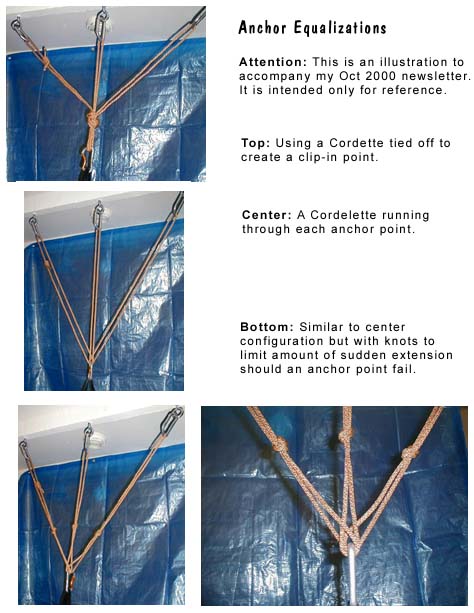 |
Jim Frankenfield jim@mountain-guiding.com; 1-877-604-0166 Mountain Guiding; Mountain Safety |
![]()
Guiding NewsletterNovember 2000 - Tech Tip SupplementAnchor Equalization
Technique Tip(s) Anchor Equalization There are several ways to "equalize" multiple anchor points in a system. The two most common ways are to use a cordelette tied off at the common end with a figure 8 knot to create a clip-in and to use a long sling or cordelette to loop between the tie-in point and each anchor point (with a twist in each loop). This text note is not intended to instruct how to do this. Books such as "Freedom of the Hills" and others should have good illustrations, and if you've taken a basic mountaineering class or a rock climbing class on leading and/or anchors you should be familiar with these two methods. The first method does not allow for "readjustment" and if the direction of pull is off just a bit the forces will all be on one anchor. However, there is no "extension" shock loading if the weighted anchor fails and forces are transferred to another anchor in the system. The second arrangement has the advantage of readjusting as the direction of pull is changed so that forces are always spread out among multiple anchor points. It is popular for this reason. The problem is that if one anchor fails there will be a major self-adjustment of lengths (a sudden extension) and the remaining anchor points will be shock loaded. Climbers sometimes like to use this setup to avoid stressing anchor points they don't like too much. To accept that one such point failing will lead to shock loading on other such points is not a good idea. The way to reduce this extension is to tie a knot in each anchor point loop, as close as possible to the tie-in but allowing enough room for self-adjustment within the range needed. (If using 2 anchor points there is still full self-adjustment up to the knots. If using 3 points the load will distribute across at least 2 anchor points. Try it out and you'll see what I mean!) Keep in mind that this is a technique note, not instruction on application. Different configurations are all potentially useful and it is reasonable to choose to apply different techniques in different situations. |
![]()
Guiding Newsletter Archive |
Climbing page |
